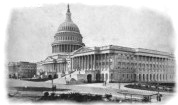German Neighborhoods in Old Washington
 The main areas where German immigrants to Washington settled were as follows:
The main areas where German immigrants to Washington settled were as follows:
Georgetown:
Western Maryland and particularly Frederick County were major areas of settlement for Germans from the Rhineland Palatinate area, including Alsace Lorraine in the early to mid-18th century.Most of the Palatinate settlers were Protestants, who left their homeland for religious freedom reasons. However, a number of German Catholics also came over, because of the broader economic opportunities available in the new world.
When the tobacco port of Georgetown was first founded in 1751, it was within the boundaries of Frederick County. Several of these early Palatinate immigrants came to the new town to seek their fortune as craftsmen, shopkeepers and small-scale agricultural merchants. Churches attended by these early Georgetowners were usually either the old log Lutheran Church on the upper part of Georgtown High Street (Georgetown Lutheran, Wisconsin Ave. and Volta Place) or, for Catholics, Holy Trinity.
The opening of the C&O canal in 1840 and its completion in 1850 coincided with another major influx of German immigration, caused by the civil war and general internal political situation in Germany in 1848. Several German-Americans came over during this time and settled in Georgetown, becoming watermen on the canal, or craftsmen or shopkeepers.
Foggy Bottom:
Some of the earlier wave of immigrants moved across Rock Creek to the Foggy Bottom area. This is the neighborhood where the State Department, Kennedy Center and George Washington University are today. Many of the post-1848 German influx also settled in this area, which soon became a culturally vibrant German-American neighborhood, with German-style breweries, food shops, and community institution. A major employer in that area was the old gasworks of the Washington Gas Light Company. Stories handed down from the Webmaster's (Irish) great-great grandfather mentioned German beer-sellers bringing fresh-brewed Pilsner-style beer to the gasworks in pails, to sell to their co-workers of all nationalities during lunch break.The Concordia Lutheran Church was established by a German-speaking congregation in 1833, and, as the merged entity of the Unity Church (19th and G, NW) still has services in German to this day, a lone relic of the once-thriving German community in this neighborhood. Concordia parishioners were buried at the Prospect Hill Cemetery at 2201 North Capitol Street, NE, Tel: (202) 667-0676. There is are card file and microfilm indexes in the cemetery office, and reportedly an on-line search system (could not find via web search). The cemetery office also has a book on its history available for sale.
German Genealogy Notes:
(1) Several Hessian mercenary soldiers who died in the War of 1812 are buried in what is now Mt. Zion Cemetery, Q St., Georgetown, between 27th St. and the Q St. (Buffalo) Bridge. This was originally a part of the Congress St. Methodist Church Cemetery.(2) The Menno Simons Historical Library in Harrisonburg, VA, Tel: (540) 432-4178, has a wealth of historical and genealogical material about German settlements in Maryland, Virginia, Pennsylvania, West Virginia, Ohio and DC.

